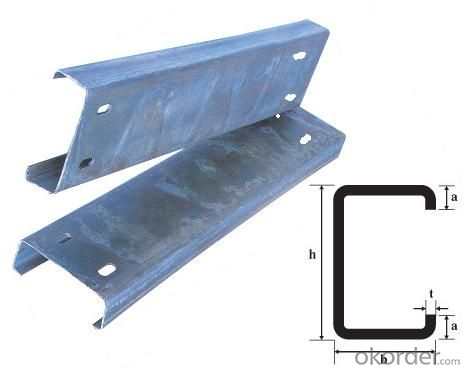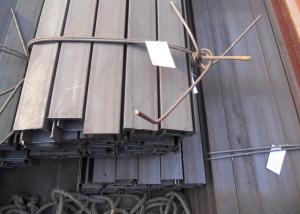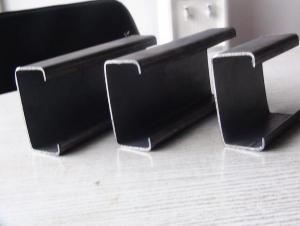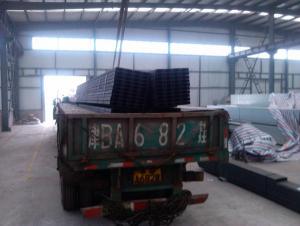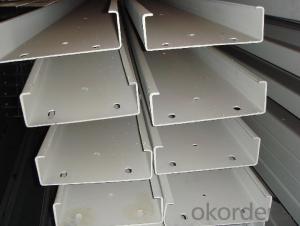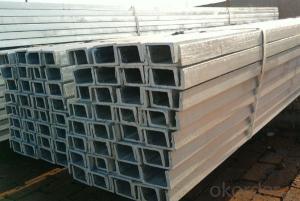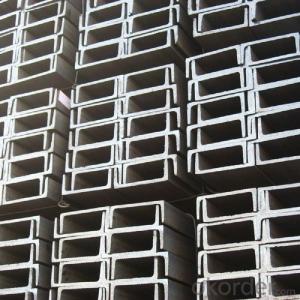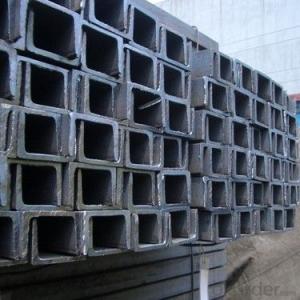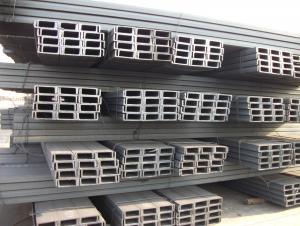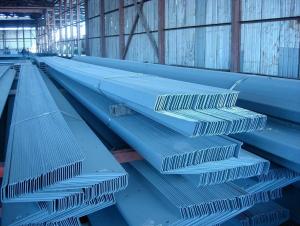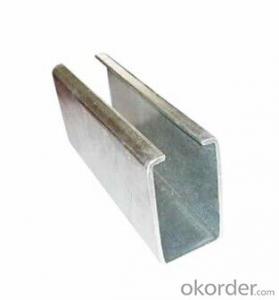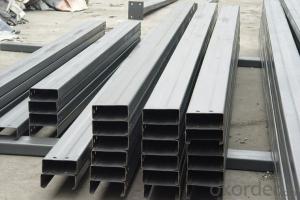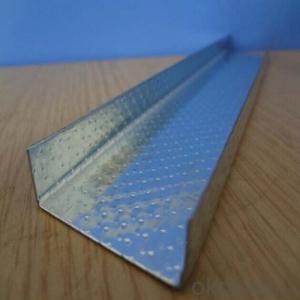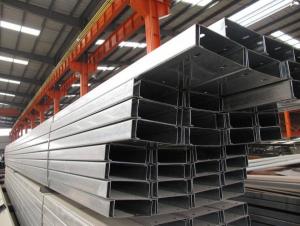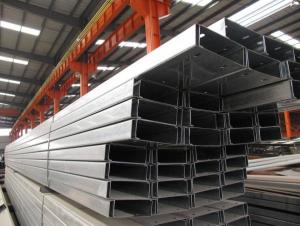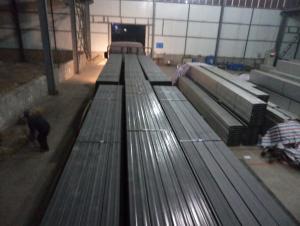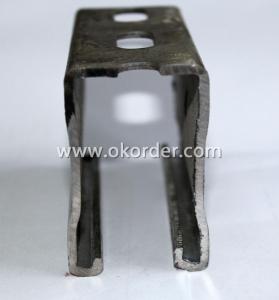Channel Steel Bar C-Type Steel Channel Bar
- Loading Port:
- Tianjin
- Payment Terms:
- TT or LC
- Min Order Qty:
- 30 m.t.
- Supply Capability:
- 40000 m.t./month
OKorder Service Pledge
OKorder Financial Service
You Might Also Like
Product Description:
OKorder is offering Channel Steel Bar C-Type Steel Channel Bar at great prices with worldwide shipping. Our supplier is a world-class manufacturer of steel, with our products utilized the world over. OKorder annually supplies products to European, North American and Asian markets. We provide quotations within 24 hours of receiving an inquiry and guarantee competitive prices.
Product Applications:
Channel Steel Bar C-Type Steel Channel Bar are ideal for structural applications and are widely used in the construction of buildings and bridges, and the manufacturing, petrochemical, and transportation industries.
Product Advantages:
OKorder's Channel Steel Bar C-Type Steel Channel Bar are durable, strong, and resist corrosion.
Main Product Features:
· Premium quality
· Prompt delivery & seaworthy packing (30 days after receiving deposit)
· Corrosion resistance
· Can be recycled and reused
· Mill test certification
· Professional Service
· Competitive pricing
Product Specifications:
| Tianjin Jujin Industry and Trading Co.,Ltd | |||||
| Dafengdui Village,Dafengdui Town,Jinghai Country,Tianjin City,China | |||||
| Tel:+86-22-68661881 Fax:+86-22-68663603 | |||||
| Country of Origin:China | |||||
| Tolerance:Accroding to clients'requirements | |||||
| Delivery time:7-25 days | |||||
| Payment term:L/C or T/T | |||||
| Packing:Mills Standard Export Strong Packing in Bundles | |||||
| Details Products Description | |||||
| C channel steel | |||||
| Material | Specificationmm | Thicknessmm | Weightkg/m | ||
| h | b | a | |||
| Q195-Q235 Q345 | 80 | 50 | 20 | 2.25 | 3.886 |
| 80 | 50 | 20 | 2.5 | 4.318 | |
| 80 | 50 | 20 | 2.75 | 4.749 | |
| 80 | 50 | 20 | 3 | 5.181 | |
| 100 | 50 | 20 | 2.25 | 4.239 | |
| 100 | 50 | 20 | 2.5 | 4.71 | |
| 100 | 50 | 20 | 2.75 | 5.181 | |
| 100 | 50 | 20 | 3 | 5.652 | |
| 120 | 50 | 20 | 2.25 | 4.592 | |
| 120 | 50 | 20 | 2.5 | 5.103 | |
| 120 | 50 | 20 | 2.75 | 5.613 | |
| 120 | 50 | 20 | 3 | 6.123 | |
| 140 | 60 | 20 | 2.5 | 5.888 | |
| 140 | 50 | 20 | 2.5 | 5.495 | |
| 140 | 60 | 20 | 3 | 7.065 | |
| 140 | 50 | 20 | 3 | 6.594 | |
| 160 | 50 | 20 | 2.5 | 5.888 | |
| 160 | 60 | 20 | 2.5 | 6.28 | |
| 160 | 70 | 20 | 2.5 | 6.673 | |
| 160 | 50 | 20 | 3 | 7.065 | |
| 160 | 60 | 20 | 3 | 7.458 | |
| 160 | 70 | 20 | 3 | 7.536 | |
| 180 | 50 | 20 | 2.5 | 6.28 | |
| 180 | 60 | 20 | 2.5 | 6.673 | |
| 180 | 70 | 20 | 2.5 | 7.065 | |
| 180 | 80 | 20 | 2.5 | 7.458 | |
| 180 | 50 | 20 | 3 | 7.536 | |
| 180 | 60 | 20 | 3 | 8.007 | |
| 180 | 70 | 20 | 3 | 8.478 | |
| 180 | 80 | 20 | 3 | 8.949 | |
| 200 | 50 | 20 | 2.5 | 6.673 | |
| 200 | 60 | 20 | 2.5 | 7.065 | |
| 200 | 70 | 20 | 2.5 | 7.458 | |
| 200 | 80 | 20 | 2.5 | 7.85 | |
| 200 | 50 | 20 | 3 | 8.007 | |
| 200 | 60 | 20 | 3 | 8.478 | |
| 200 | 70 | 20 | 3 | 8.949 | |
| 200 | 80 | 20 | 3 | 9.42 | |
| 220 | 50 | 20 | 2.5 | 7.065 | |
| 220 | 60 | 20 | 2.5 | 7.458 | |
| 220 | 70 | 20 | 2.5 | 7.85 | |
| 220 | 80 | 20 | 2.5 | 8.243 | |
| 220 | 50 | 20 | 3 | 8.478 | |
| 220 | 60 | 20 | 3 | 8.949 | |
| 220 | 70 | 20 | 3 | 9.42 | |
| 220 | 80 | 20 | 3 | 9.891 | |
| 240 | 50 | 20 | 2.5 | 7.458 | |
| 240 | 60 | 20 | 2.5 | 7.85 | |
| 240 | 70 | 20 | 2.5 | 8.243 | |
| 240 | 80 | 20 | 2.5 | 8.635 | |
| 240 | 50 | 20 | 3 | 8.949 | |
| 240 | 60 | 20 | 3 | 9.42 | |
| 240 | 70 | 20 | 3 | 9.891 | |
| 240 | 80 | 20 | 3 | 10.362 | |
FAQ:
Q1: Why buy Materials & Equipment from OKorder.com?
A1: All products offered byOKorder.com are carefully selected from China's most reliable manufacturing enterprises. Through its ISO certifications, OKorder.com adheres to the highest standards and a commitment to supply chain safety and customer satisfaction.
Q2: How do we guarantee the quality of our products?
A2: We have established an advanced quality management system which conducts strict quality tests at every step, from raw materials to the final product. At the same time, we provide extensive follow-up service assurances as required.
Q3: How soon can we receive the product after purchase?
A3: Within three days of placing an order, we will begin production. The specific shipping date is dependent upon international and government factors, but is typically 7 to 10 workdays.
Images:
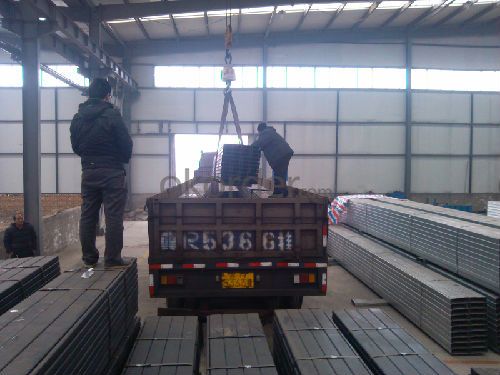
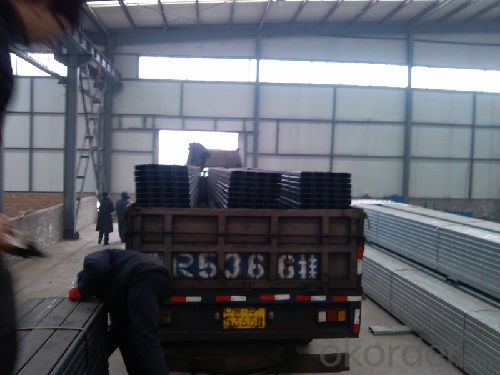
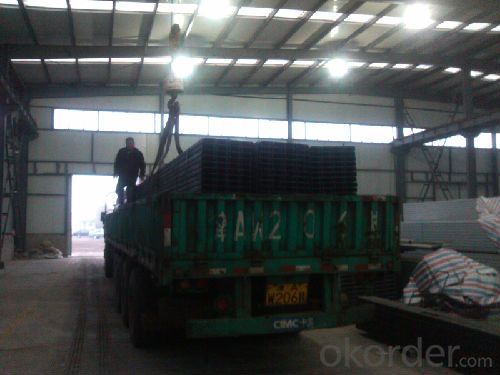
- Q: What are the methods and the price of building the floor?
- Determine the area: according to the force of the wall and load-bearing situation, you can clear the general scope of the attic. There is no need to blindly pursue the area.There are some higher floors, or duplex rooms with a hollow living room friends, perhaps they will have to build attic needs, and build attic and involves some deeper knowledge
- Q: What are they specifically connected to the bridge? Say more details!
- Bridge Specifications larger, more load-bearing cable, it is necessary to use angle steel and channel steel to make bridge tray to support the bridge
- Q: What are the standard dimensions of steel channels?
- The specific type and design of steel channels can cause variations in their standard dimensions. Typically, steel channels are measured by their height, width, and thickness. Standard dimensions for steel channels commonly range from 1 inch to 8 inches in height, 0.5 inch to 3 inches in width, and 0.125 inch to 0.5 inch in thickness. These dimensions are usually specified in inches or millimeters. It should be noted that customized steel channels can be created to suit specific project requirements. In these cases, the dimensions may differ from the aforementioned standard sizes. Additionally, different countries or regions may have their own unique standards for steel channel dimensions. To ensure the correct dimensions are used for a particular application, it is essential to consult the appropriate industry standards, regulations, and specifications when working with steel channels.
- Q: Do you have any width 20 cm wide? What's the model number and how much is it?
- Height of 20 points, two models: 20 channel, height 200, leg width 73, waist thickness of 7, theoretical weight of 22.637 kg per meter; 20a, channel steel, height 200, leg width 75, waist thickness 9, theoretical weight of 25.777 kg.
- Q: Can steel channels be used for raised flooring systems?
- Yes, steel channels can be used for raised flooring systems. Steel channels are durable and strong, making them an ideal choice for supporting raised floors. The channels can be laid out in a grid pattern and provide a stable base for the raised floor panels. Additionally, steel channels can easily support heavy loads, making them suitable for areas with high foot traffic or equipment installations. Their corrosion-resistant properties also make them a long-lasting option for raised flooring systems.
- Q: What are the different alloy compositions available for steel channels?
- Steel channels are available in various alloy compositions, each with its own unique properties and advantages. Some commonly used alloy compositions include: 1. Carbon Steel: This is the most basic and widely used type of steel. It primarily consists of iron and carbon, along with small amounts of other elements. Carbon steel channels offer good strength and durability, making them suitable for various applications. 2. Stainless Steel: This alloy composition contains iron, chromium, and nickel. Stainless steel channels are highly resistant to corrosion and possess excellent strength and heat resistance. They are commonly used in environments where resistance to rust and staining is crucial, such as in the food industry or marine applications. 3. Alloy Steel: This composition consists of iron, carbon, and other alloying elements like manganese, chromium, or molybdenum. Alloy steel channels offer enhanced strength, hardness, and wear resistance compared to carbon steel. They find applications in industries requiring high tensile strength, such as construction, automotive, or machinery manufacturing. 4. High-Strength Low-Alloy (HSLA) Steel: HSLA steel channels contain small amounts of alloying elements like copper, vanadium, or niobium. These alloys enhance the strength and toughness of the steel while maintaining good weldability and formability. HSLA steel channels are commonly used in structural applications, bridges, or automotive components. 5. Weathering Steel: This composition includes iron, chromium, and copper. Weathering steel channels are designed to develop a protective rust-like coating when exposed to the atmosphere. This coating acts as a barrier against further corrosion and eliminates the need for painting. Weathering steel channels are often used in outdoor structures like bridges or building facades. Choosing the appropriate alloy composition for steel channels is crucial and depends on specific application requirements, considering factors such as strength, corrosion resistance, weldability, and cost. Seeking guidance from a materials engineer or steel supplier can help determine the most suitable alloy composition for steel channels.
- Q: Can steel channels be used in overhead crane systems?
- Yes, steel channels can be used in overhead crane systems. Steel channels are commonly used in the construction of overhead crane systems due to their structural integrity and strength. They provide a sturdy support system for the crane's movement along the rails and can withstand the heavy loads typically lifted by overhead cranes. Additionally, steel channels can be easily welded or bolted together to create the required length and configuration for the crane system. Overall, steel channels are a reliable and cost-effective option for overhead crane systems.
- Q: How do steel channels contribute to the overall cost-effectiveness of a building?
- Steel channels contribute to the overall cost-effectiveness of a building by providing structural support and reducing the need for excessive materials. These channels are versatile and can be easily fabricated to fit specific requirements, which reduces waste and construction time. Additionally, steel channels have high strength-to-weight ratio, allowing for lighter building designs and lower transportation costs. Their durability and resistance to corrosion also result in long-term cost savings by minimizing maintenance and replacement expenses.
- Q: What are the common maintenance requirements for steel channels?
- To ensure the longevity and optimal performance of steel channels, regular maintenance is necessary. Here are some common maintenance tasks for steel channels: 1. Regularly clean the steel channels to remove dirt, dust, and debris. Use a mild detergent and water solution, rinse with clean water, and dry with a soft cloth. Avoid abrasive cleaners or scrub brushes that could damage the surface. 2. Check for corrosion regularly, especially in high humidity or moisture-exposed areas. Address any signs of rust or corrosion promptly. Remove surface rust with a wire brush or abrasive pad, and apply a suitable rust inhibitor or paint to prevent further corrosion. 3. Lubricate moving parts, such as sliding doors or windows, regularly to ensure smooth operation. Use lubricating oil or grease specifically designed for steel to prevent friction and wear. 4. Periodically inspect the steel channels for any damage or structural issues. Look for cracks, dents, or deformities that could compromise strength and stability. Consult a professional for repair or replacement if any issues are found. 5. Check the paintwork regularly and touch up any chipped, faded, or peeled areas. This not only enhances the appearance but also provides added protection against corrosion. 6. Ensure proper drainage systems are in place to prevent water accumulation. Standing water can cause corrosion and structural problems. Clear drains and gutters of debris to maintain proper water flow. By following these maintenance tasks, steel channels can be maintained in good condition, ensuring durability and functionality for years to come.
- Q: Are steel channels suitable for swimming pool installations?
- No, steel channels are not suitable for swimming pool installations as they are prone to rust and corrosion when exposed to water and chemicals.
Send your message to us
Channel Steel Bar C-Type Steel Channel Bar
- Loading Port:
- Tianjin
- Payment Terms:
- TT or LC
- Min Order Qty:
- 30 m.t.
- Supply Capability:
- 40000 m.t./month
OKorder Service Pledge
OKorder Financial Service
Similar products
Hot products
Hot Searches
Related keywords




